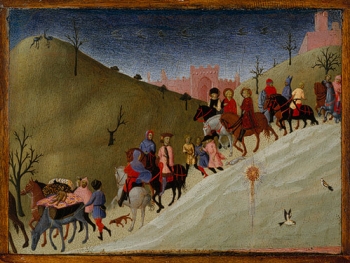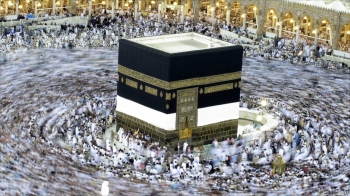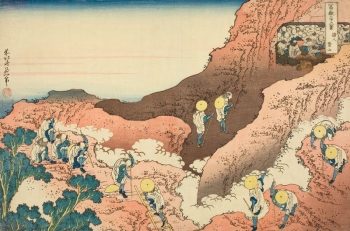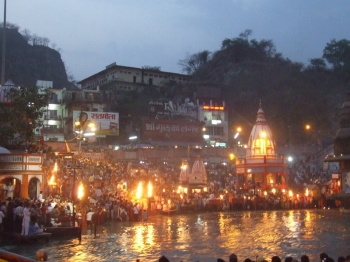 Journey of the Magi 1435. Source:www.metmuseum.org
Journey of the Magi 1435. Source:www.metmuseum.org Hajj Pilgrimage. Photo Credit: BBC News
Hajj Pilgrimage. Photo Credit: BBC News Pilgrimage and Buddhist Art. Source: Asia Society
Pilgrimage and Buddhist Art. Source: Asia Society Haridwar Pilgriimage. Photo Credit: www.traveldealsfinder.com
Haridwar Pilgriimage. Photo Credit: www.traveldealsfinder.comThen do folk long to go on pilgrimage,
And palmers to go seeking out strange strands,
To distant shrines well known in sundry lands.
And specially from every shire’s end
of England they to Canterbury wend,
The holy blessed martyr there to seek
Who helped them when they lay so ill and weak.
- Prologue, Canterbury Tales. Geoffrey Chaucer
Lo, the hills of As-Safa and Al-Marwah are among the indications of Allah. It is therefore no sin for him who is on pilgrimage to the House of God or visiteth it, to go around them (as the pagan custom is). And he who doeth good of his own accord, for him lo! Allah is Responsive, Aware.
- Qur’an, Surah 2 v. 158
And they, Ananda, who shall die while they, with believing heart, are journeying on such pilgrimage, shall be reborn after death, when the body shall dissolve, in the happy realms of heaven.
- Mahaparinirvana Sutra
I am setting forth on 7 March 2014 to India on a pilgrimage to follow, as it were, the footsteps of Gotama Buddha, to commemorate his life and teachings by visiting three of the main Buddhist sites which encapsulate his life. I invite you to follow me along the pilgrim’s path as I experience the next nine days. First though, in this piece I will set the scene and contextualise the pilgrimage journey by discussing its function, purpose, characteristics and give a short introduction to pilgrimage in the three main religious traditions of Christianity, Islam and Buddhism.
Pilgrimage is both a personal and communal journey reinforcing the believer’s search for spiritual fulfillment and keeping in physical contact as well with their religion’s physical manifestations of faith. The pilgrim makes a commitment to undertake a conscious physical journey along a path which is also temporal in that the sites to be visited are rooted in time and have special significance for the religion: places that mark important points in the founder’s life,
miracles and martyrdoms of the believers and saints. While on pilgrimage, the pilgrim removes himself from daily life, its worries and comforts, to become detached and focused on the spiritual. The believer is thus somewhere between the ordinary and sacred planes during the time spent on pilgrimage.
The physical element in pilgrimage is pervasive, there is a constant interaction between the pilgrim’s wish to connect the inner process with the external physical surroundings: the path itself, sacred buildings, relics, ritual activities, partaking in charity and interacting with fellow pilgrims because you are separate, yet part of a greater whole. You are expected to walk long distances over difficult terrain to reach the holy sites which are usually found in high places i.e. tops of mountains to illustrate the closeness to the sacred. In addition to walking, the pilgrim will need to ascend (on foot) and once reaching the goal there is further circumambulation of the sacred site. The pilgrim is also expected to concentrate on the spiritual continually throughout the pilgrimage which may last for many days.
Christianity has a long history of pilgrimage from the medieval period onward. Pilgrims wished to visit places where Jesus, the Man, had physically walked and physical traces of God. Therefore, the Holy Land was their first object, the Sea of Galilee, Bethlehem and Jerusalem, any place connected with his birth, crucifixion and resurrection. They would try to pick up physical relics they could take home, for example stones from the path where Jesus walked. Christian pilgrims also visit places associated with saints, martyrs, and miracles.
In Islam, the Hajj or pilgrimage to Mecca is one of the Five Pillars and is expected of every able-bodied Muslim if it is possible to be undertaken. Muslims venerate the Ka’ba by circumambulating it seven times in a counter-clockwise direction while all the time attempting to touch it, kiss it or point at it. The need for a physical connection with what is held to be sacred is clearly illustrated here.
Pilgrims then go to Safa to complete seven runs between here and Marwa (approximately two miles) to commemorate Hagar’s search for water to give her son Ishmael, the son of Abraham. They also cast seven pebbles at stone pillars which represent Satan. Abraham repulsed him by throwing stones when Satan tried to get Abraham to disobey Allah and not sacrifice Ishmael. An animal will be sacrificed and its meat given to charity for the poor.
During the Hajj, all the pilgrims wear a white shroud to show equality. Differences in wealth or social status are thus eliminated. It also symbolizes purity. After the completion of the Hajj many will go to Medina to visit the Prophet’s tomb.
In Buddhism, the life of the Buddha serves as a paradigm of a spiritual path which allows for awakening and enlightenment if followed vigorously. This path is accessible to every sentient being. In visiting sacred places of importance to the historical Buddha and his dhamma, pilgrims exhibit a visible, timeless testimony to Buddhist religious practice.
The Eight Great Sites of Wonder (Astamahapratiharya) include Lumini, Bodhgaya, Sarnath, Kushinagara and the sites of his four miraculous events. These places are the centre of Buddhist pilgrimage. As there will be further reports from the pilgrimage path during the next nine days I will wait until then to go into further detail.
I welcome all of you to follow me on this transformative journey from a personal and communal point of view. Of necessity, this will be a personal journey but one intersected with the journey of my fellow pilgrims. Ehi sattva cara brahma-caryam (Come O sentient being and take up the spiritual life!)


















